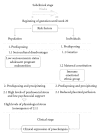Genesis of preeclampsia: an epidemiological approach
- PMID: 22462008
- PMCID: PMC3302023
- DOI: 10.5402/2012/916914
Genesis of preeclampsia: an epidemiological approach
Abstract
THERE ARE ANALYZED SOME OF THE MAIN ASPECTS RELATED TO THE CAUSALITY OF PREECLAMPSIA, PRIVILEGING TWO TYPES OF MODELS: the clinic model and the epidemiologic model, first one represented by the hypothesis of the reduced placental perfusion and the second one considering the epidemiologic findings related to the high levels of psychosocial stress and its association with preeclampsia. It is reasoned out the relevance of raising the causality of the disease from an interdisciplinary perspective, integrating the valuable information generated from both types, clinical and epidemiologic, and finally a tentative explanatory model of preeclampsia is proposed, the subclinical and sociocultural aspects that predispose and trigger the disease are emphasized making aspects to stand out: the importance of reduced placental perfusion as an indicator of individual risk, and the high levels of physiological stress, as a result of the unfavorable conditions of the psychosocial surroundings (indicator of population risk) of the pregnant women.
Similar articles
-
[The biopsychosocial dimension of preeclampsia: a conceptual-empirical approach].Ginecol Obstet Mex. 2009 May;77(5):231-7. Ginecol Obstet Mex. 2009. PMID: 19496518 Review. Spanish.
-
Heterogeneous causes constituting the single syndrome of preeclampsia: a hypothesis and its implications.Am J Obstet Gynecol. 1996 Nov;175(5):1365-70. doi: 10.1016/s0002-9378(96)70056-x. Am J Obstet Gynecol. 1996. PMID: 8942516 Review.
-
Placental perfusion in normal pregnancy and early and late preeclampsia: a magnetic resonance imaging study.Placenta. 2014 Mar;35(3):202-6. doi: 10.1016/j.placenta.2014.01.008. Epub 2014 Jan 31. Placenta. 2014. PMID: 24529946
-
Preeclampsia: what we know and what we do not know.Semin Perinatol. 2000 Feb;24(1):24-8. doi: 10.1016/s0146-0005(00)80050-6. Semin Perinatol. 2000. PMID: 10709854 Review.
-
Reduced uterine perfusion pressure model is not successful to mimic severe preeclampsia.Placenta. 2011 Sep;32(9):675-680. doi: 10.1016/j.placenta.2011.06.005. Epub 2011 Jun 30. Placenta. 2011. PMID: 21722954
Cited by
-
Differential Methylation in Promoter Regions of the Genes NR3C1 and HSP90AA1, Involved in the Regulation, and Bioavailability of Cortisol in Leukocytes of Women With Preeclampsia.Front Med (Lausanne). 2020 Jun 16;7:206. doi: 10.3389/fmed.2020.00206. eCollection 2020. Front Med (Lausanne). 2020. PMID: 32656215 Free PMC article.
-
Reduction of maternal mortality due to preeclampsia in Colombia--an interrupted time-series analysis.Colomb Med (Cali). 2014 Mar 30;45(1):25-31. eCollection 2014 Jan-Mar. Colomb Med (Cali). 2014. PMID: 24970956 Free PMC article.
-
Elevated levels of neuropeptide Y in preeclampsia: A pilot study implicating a role for stress in pathogenesis of the disease.Neuropeptides. 2016 Feb;55:127-35. doi: 10.1016/j.npep.2015.09.006. Epub 2015 Sep 25. Neuropeptides. 2016. PMID: 26431933 Free PMC article.
References
-
- López-Llera M. Complexity and complicity in eclampsia: barriers or bridges? Medical Hypotheses. 1995;45(6):591–601. - PubMed
-
- Dekker G, Sibai B. Primary, secondary, and tertiary prevention of pre-eclampsia. The Lancet. 2001;357(9251):209–215. - PubMed
-
- Roberts JM, Cooper DW. Pathogenesis and genetics of pre-eclampsia. The Lancet. 2001;357(9249):53–56. - PubMed
-
- Luft FC. Pieces of the preeclampsia puzzle. Nephrology Dialysis Transplantation. 2003;18(11):2209–2210. - PubMed
LinkOut - more resources
Full Text Sources
Research Materials


